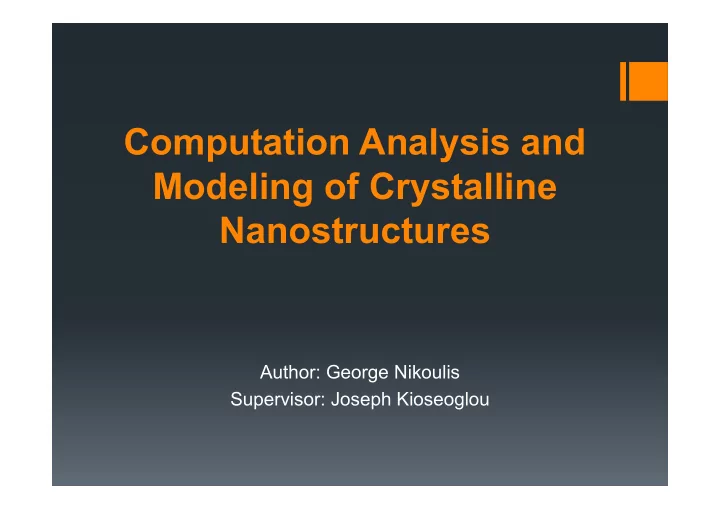

Computation Analysis and Modeling of Crystalline Nanostructures Author: George Nikoulis Supervisor: Joseph Kioseoglou
Tools Used Visual Studio C++ Win32 API x86 Assembly __asm{ } Open GL libcmtd.lib
Theory 7 Crystal Systems 14 Bravais Lattices 230 Space groups
Theory
Hermann-Mauguin • Uses two to four symbols –Im3m , Pm • First symbol specifies the Bravais Lattice P — Primitive I — Body centered (from the German "Innenzentriert") F — Face centered (from the German "Flächenzentriert") C — Base centered R — Trigonal
Hermann-Mauguin
Hermann-Mauguin The number n show a spin symmetry around that axis with a spin of (360/n). (n-fold axis) If the number has a minus symbol in front means we have a rotoinversion axis which is a combination of rotation and a reflection. Screw axis (n m ) with a symmetry of spin m*(360/n) and a translation of 1/n of the primary axis
Hermann-Mauguin Letters specifies the type of reflection plane that is normal to the axis M is a symmetry operation mapping all atoms through the mirror.
International Tables for Crystallography Numbers the space groups from number 1 to 230.
Program • Constructs a crystal, from a POSCAR. Multiply the unit cell in order to construct a supercell. • Cutting along {100} {110} {111} or {10-10} {11-20} {0001} or by a radius R. • Builds a new POSCAR with the new crystal. • The name indicates the surfaces we used or the specific nanoparticle we chose.
POSCAR_GaN Ga2 N2 1.0 3.216290 0.000000 0.000000 ‐ 1.608145 2.785389 0.000000 0.000000 0.000000 5.239962 Ga N 2 2 Direct 0.333333 0.666667 0.500880 Ga 0.666667 0.333333 0.000880 Ga 0.333333 0.666667 0.124120 N 0.666667 0.333333 0.624120 N
Program
Pd-H-Na Sphere System: tetragonal Space group: I4/mmm Space group number: 139 a : 3.590 Å b : 3.590 Å c : 6.255 Å
Na-Cl Figure1 System: Cubic Space group: Fm ‐ 3m Space group number: 225 a : 4.025 Å b : 4.025 Å c : 4.025 Å
Pd Cube System: Cubic Space group: Fm ‐ 3m Space group number: 225 a : 3.8907 Å b : 3.8907 Å c : 3.8907 Å α : 90.000 ° β : 90.000 ° γ : 90.000 ° Junlei Zhao et al. Formation Mechanism of Fe Nanocubes (2016)
Construction Vyacheslav Gorshkov et al “Shape Selection in Diffusive Growth of Colloids and Nanoparticles” Sung Joo Kim et al Chemistry of Materials 29 (5), 2016 ‐ 2023, (2017) Panagiotis Grammatikopoulos et al “Coalescence ‐ induced crystallization wave in Pd nanoparticles”
Ni Figure2 System: Cubic Space group: Fm ‐ 3m Space group number: 225 a : 3.524 Å b : 3.524 Å c : 3.524 Å α : 90.000 ° β : 90.000 ° γ : 90.000 ° Beilstein J Nanotechnol 2015; 6: 361–368.
Ti Hexagonal Ti GaN Crystal System: hexagonal Crystal System: hexagonal Space group: P6 3 /mmc Space group: P6 3 mc Space group number: 194 Space group number: 186 a : 2.939 Å a : 3.216 Å b : 2.939 Å b : 3.216 Å c : 4.641 Å c : 5.240 Å α : 90.000 ° α : 90.000 ° β : 90.000 ° β : 90.000 ° γ : 120.000 ° γ : 120.000 ° Christine Vauthier, Gilles Ponchel “Polymer Nanoparticles for Nanomedicines”
{10-10} and {11-20} family
{10-10} and {11-20} family
{11-20} family looking at (0001)
{11-20} family looking at (0001)
{11-20} family looking at (11-20)
{11-20} family looking at (11-20)
{10-10} family looking at (0001)
{10-10} family looking at (0001)
{10-10} family looking at (10-10)
{10-10} family looking at (10-10)
Cr Wulff Construction {100} dominance System: Cubic Space group: Im ‐ 3m Space group number: 229 a : 2.91 Å b : 2.91 Å c : 2.91 Å α : 90.000 ° β : 90.000 ° γ : 90.000 ° Sung Joo Kim et al Chemistry of Materials 29 (5), 2016 ‐ 2023, (2017)
Cr Wulff Construction {110} dominance System: Cubic Space group: Im ‐ 3m Space group number: 229 a : 2.91 Å b : 2.91 Å c : 2.91 Å α : 90.000 ° β : 90.000 ° γ : 90.000 ° Sung Joo Kim et al Chemistry of Materials 29 (5), 2016 ‐ 2023, (2017)
Cr Rhombic Dodecahedron System: Cubic Space group: Im ‐ 3m Space group number: 229 a : 2.91 Å b : 2.91 Å c : 2.91 Å α : 90.000 ° β : 90.000 ° γ : 90.000 ° Evelyn Auyeung et al, 505,73–77(02 January 2014)
Rod ‐ like Sung Joo Kim et al, Chemistry of Materials 29 (5), 2016 ‐ 2023, (2017)
Ag Cuboctahedron System: Cubic Space group: Fm ‐ 3m Space group number: 225 a : 4.08 Å b : 4.08 Å c : 4.08 Å α : 90.000 ° β : 90.000 ° γ : 90.000 ° H. Hofmeister et al, Shape and internal structure of silver nanoparticles (2005)
Conclusion Cubic {100} {110} {111} Hexagonal {10-10} {11-20} {0001} Any other surface More I/O types Easy to use, Friendly environment Optimization
Thank you for your attention
Recommend
More recommend